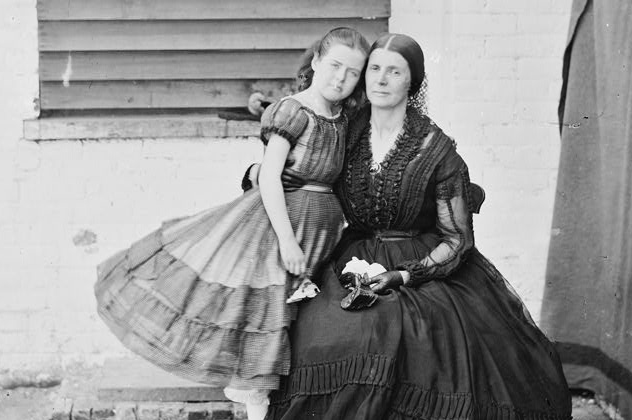 Humans
Humans  Humans
Humans  Movies and TV
Movies and TV 10 Holiday Movies Released at Odd Times of the Year
 Politics
Politics 10 Countries Where Religion and Politics Are Inseparable
 Weird Stuff
Weird Stuff 10 Freaky Times When Famous Body Parts Were Stolen
 Miscellaneous
Miscellaneous 10 Interesting Things Manufacturers Stopped Making and Why
 Gaming
Gaming 10 Funny Tutorials in Games
 History
History 10 Fascinating Little-Known Events in Mexican History
 Facts
Facts 10 Things You May Not Know about the Statue of Liberty
 Movies and TV
Movies and TV 10 Movie Adaptions That Brought Popular Songs to Life
 Health
Health 10 Miraculous Advances Toward Curing Incurable Diseases
 Humans
Humans 10 One-of-a-kind People the World Said Goodbye to in July 2024
 Movies and TV
Movies and TV 10 Holiday Movies Released at Odd Times of the Year
 Politics
Politics 10 Countries Where Religion and Politics Are Inseparable
Who's Behind Listverse?

Jamie Frater
Head Editor
Jamie founded Listverse due to an insatiable desire to share fascinating, obscure, and bizarre facts. He has been a guest speaker on numerous national radio and television stations and is a five time published author.
More About Us Weird Stuff
Weird Stuff 10 Freaky Times When Famous Body Parts Were Stolen
 Miscellaneous
Miscellaneous 10 Interesting Things Manufacturers Stopped Making and Why
 Gaming
Gaming 10 Funny Tutorials in Games
 History
History 10 Fascinating Little-Known Events in Mexican History
 Facts
Facts 10 Things You May Not Know about the Statue of Liberty
 Movies and TV
Movies and TV 10 Movie Adaptions That Brought Popular Songs to Life
 Health
Health 10 Miraculous Advances Toward Curing Incurable Diseases
10 Female Soldiers Who Fought For The Bad Guys
Although they haven’t always been accepted on history’s battlefields, women have still played vital roles in a number of wars. While some, like Molly Pitcher, are celebrated heroes, others are remembered ignominiously because they served the “bad guys” in national and global conflicts.
10Mildred Gillars

Though not nearly as famous as Iva Toguri and the other women who were known as Tokyo Rose during World War II, Mildred Gillars played her part as a propagandist for the Germans and was known to the Allied forces as Axis Sally. An American from Ohio, she moved to Germany, where she struggled to make a living in the years before World War II. Once war broke out, she became romantically involved with the station manager at the radio station where she worked, a man who prompted her to become an on-air talent spewing hateful propaganda to the Allied forces.
One of her favorite things to taunt the soldiers with was the supposed infidelity of their wives and girlfriends. In addition, Gillars liked explaining, in grim detail, the injuries and deaths of various servicemen to their families. In 1946, she was brought back to America, where she stood trial for treason. After spending 12 years in prison, she was released, eventually dying in poverty in 1988.
9Antonia Ford

The daughter of a distinguished merchant in Fairfax, Virginia, Antonia Ford was a volunteer Confederate spy in her spare time, gleaning any information she could from the Union officers she entertained at Fairfax Station. That intel later found its way to Jeb Stuart, a brigadier general, and John S. Mosby, a colonel in the Confederate Army. Mostly laden with details about troop strengths and locations, the documents given by Ford proved invaluable, so much so that she was given a letter by Stuart naming her his aide-de-camp (French for “assistant in the field”).
However, that letter was Ford’s undoing, as it was discovered by a Union counterspy who promptly turned her in to Major Joseph Willard, the acting marshal of the town. Arrested and released further south, Ford returned, only to be arrested a second time. This time, Willard pushed hard for her release. She was granted one on the condition that she swear a loyalty oath to the Union. She did, and she later married Willard, who had resigned from the army and divorced his previous wife. Seven years and three kids later, Ford died.
8Ann Bates

Before the American Revolution, Ann Bates was a simple schoolteacher and store owner in Philadelphia, content with the status quo of British colonialism. When tensions erupted into outright war, Bates looked for a way to help the loyalist forces. In 1778, she finally succeeded, joining up with the espionage network of Sir Henry Clinton. (The fact that her husband was a soldier in Clinton’s army certainly helped.) Utilizing her knowledge of weaponry, Bates would disguise herself as a peddler and wander among the American forces, observing any details she could and reporting them back to Clinton’s men.
After a period of successful espionage, Bates was rounded up by the Americans “on suspicion,” although she was eventually let go. She was very upset with the whole ordeal, claiming that the woman who searched her stole her silver shoe buckles, among other things. Bates continued reporting to Clinton’s men until 1780, and her greatest contribution to the British war effort was probably information about American troop movements in Rhode Island, which led to their retreat from the area. After the end of the war, Bates moved to England, where she received a small pension as a reward for her service to the Crown.
7Malinda Blalock

Though she later joined the Union to fight as a female guerrilla, Malinda Blalock began her wartime career with the Confederacy disguised as a man. Born and raised in North Carolina, she sympathized with the Union. Fearing that her husband would soon be conscripted into the Confederate Army, Blalock devised a plan to have him enlist with the express intent of later deserting in Virginia. Blalock herself, unbeknownst to her husband, cut her hair and disguised herself as “Sam” Blalock, a brother of her husband, and joined the army as well.
Eventually, she found her husband and the pair served together until fighting broke out. Blalock’s husband managed to escape without injury, but she was not so lucky—a bullet struck her shoulder and the surgeon discovered her true identity while he removed it. Sources disagree as to whether the surgeon reported her or whether Blalock came clean later. Either way, both Blalocks were still intent on deserting. Her husband rolled around in poison sumac and complained to the camp doctors, who thought it might be smallpox, and he was discharged. Eventually, the pair made it to Union territory, where they served until the end of the Civil War.
6Rose Greenhow

A renowned Confederate spy, Rose Greenhow utilized her fame as a celebrated Washington hostess to schmooze her way through the social circles of the Union hierarchy. Extremely well connected, she was able to provide the Confederacy with detailed reports on the defenses of the nation’s capital as well as the movements of Union troops. Her intel greatly helped the Confederate Army during the First Battle of Bull Run, a fight in which the Confederacy routed the Union.
Greenhow soon found herself under the watchful eye of famed detective Allan Pinkerton, who placed her under house arrest and, later, in the Old Capital Prison. Nevertheless, she was still able to get messages out, mainly through cryptic notes placed in unusual places. One such message was put into the bun of a woman’s hair. Eventually, Greenhow proved to be too much of a security risk and was exiled to the Confederates, who sent her to Europe to act as a propagandist against the Union.
In 1864, a boat she was traveling on was attacked by a Union gunboat and ran aground. Greenhow fled in a rowboat, but never made it to shore alive—her little boat was dragged down by the weight of the gold she had received in royalties for a book she’d written.
5Carla Costa

A young German spy during World War II, Carla Costa spent her wartime years in Italy observing Allied troop levels and movements. Thanks to her youth (she was only 17) and her plain looks, Costa was assumed to be just another average Italian girl who’d been displaced by the war. Using this to her advantage, she became one of the most successful German spies in Italy. She was once given a private audience with Benito Mussolini, the leader of Italy at the time. During their meeting, Mussolini told her, “Young woman, if all Italian women were like you, we’d win this damnable war.”
Costa was eventually caught when her partner, Mario Martinelli, sold her out after being captured. For her part, Costa pretended she’d never seen Martinelli and steadfastly refused to cooperate with her captors. Unfortunately for her, all German spies at the time were given a silk handkerchief with a secret note on it. When held over a flame for 30 minutes, the words (in German) “Member of the Army. Take to Air Force Headquarters” would appear. The Allies knew about this and used it to confirm that she was a spy. Martinelli was executed by firing squad and Costa was given a sentence of 20 years in prison. Her sentence was drastically shortened after the war, when the Italian government released her.
4Yoshiko Kawashima

Born a princess of the Manchu people in China, Yoshiko Kawashima, at the age of eight, was given to her father’s friend Naniwa Kawashima, a Japanese man, as a sign of the friendship which existed between the two. After a failed arranged marriage to a Mongol prince, Kawashima lived a bohemian life in Tokyo, eventually outgrowing it and traveling extensively around the world. In 1928, in Shanghai, she met a Japanese general named Takayoshi Tanaka who took her under his wing, believing that she might one day prove useful as a spy.
Known in espionage circles as Eastern Jewel, Kawashima was first ordered to create a citywide disturbance in Shanghai, a move designed to give Japanese forces an excuse to invade the city. Forces did indeed enter the city, but diplomatic pressure soon forced them out. Kawashima later used a series of fake assassination attempts to persuade the former Qing emperor Pu Yi to become the ruler of the newly formed Japanese puppet state of Manchukuo. At the end of the war, she changed her name and went into hiding. In November 1945, she was captured by the Chinese and held for three years until she was executed as a traitor.
3Hanna Reitsch

Unlike the other women on this list, Hanna Reitsch was neither a spy nor a soldier; she served Nazi Germany as a test pilot. In her early life, she had originally wanted to become a doctor, though she wanted to learn how to fly so she could service more people in Africa. After convincing her parents to let her go through with it, Reitsch learned how to fly a glider, setting numerous endurance and altitude records for women in the process. Eventually, she decided that a powered aircraft would serve her better and decided to learn how to be a pilot.
Reitsch began flying for the Luftwaffe in 1937, one of only six women to fly an aircraft during World War II in Germany. She was awarded a number of medals by the Nazis, including an Iron Cross (Second Class) for her experiments in defeating the barrage balloons over London. A crash landing of a Messerschmitt Me 163 Komet ended with an Iron Cross (First Class) for Reitsch, as well as a five-month hospital stay. Reitsch was also a celebrated pilot around the world—before the war, she often toured other countries to participate in air displays.
She and her brother Kurt were the only members of her immediate family to survive the war. Sensing Germany’s imminent defeat and fearing the Soviets, Reitsch’s father killed the five members of his household before turning the gun on himself. Reitsch was also questioned about Hitler’s suicide, as she was one of the few people to visit his bunker in his last days. She was even briefly accused of sneaking him out of the bunker on her plane.
2Loreta Janeta Velazquez

A Cuban by birth, Loreta Janeta Velazquez traveled as a young child to the home of her aunt in New Orleans, where she completed her English education. Enamored with female soldiers, especially the exploits of Joan of Arc, Velazquez was elated when the American Civil War broke out. She immediately began perfecting the mannerisms of a man, even purchasing a custom-made girdle so she could hide the shape of her body.
Shortly after war broke out, her husband was killed in an accident, and Velazquez decided to go to war herself. Calling herself Harry T. Buford, she participated in a number of battles, including the First Battle of Bull Run. Velazquez later claimed in her memoirs to have been found out twice, eventually becoming a spy for the Confederacy. Although many Civil War scholars doubt the veracity of some of her claims, Velazquez wrote about a number of minute details, including weather and commanding officers, which could only have been known by a participant of the battles.
1Violette Morris

A celebrated French driver widely known for her skill behind the wheel, Violette Morris was also a champion in swimming, boxing, football, running, and weightlifting, among other things. Born just before the start of the 20th century, she ended up serving in the Red Cross as an ambulance driver in the thick of the war in Verdun. Simply known as “la Morris” after her shining performance at the Paris Olympics, she was eventually refused a license to take part in the 1928 Olympics, as the governing body disapproved of her homosexual lifestyle. This prompted her to switch her attention to racing, a move which ended with her undergoing a double mastectomy to make sure her breasts didn’t obstruct her at the wheel.
Shortly before the Berlin Olympics in 1936, Hitler found out about Morris’s predicament and invited her to be his personal guest. When she returned to Paris, not only was she a spy for Nazi Germany, she was also a torturer for the Gestapo. Given the nickname “the hyena of the Gestapo” by the French Resistance, Morris brought down the ire of London, who dispatched commandos against her. She was eventually assassinated behind the wheel of her car.








